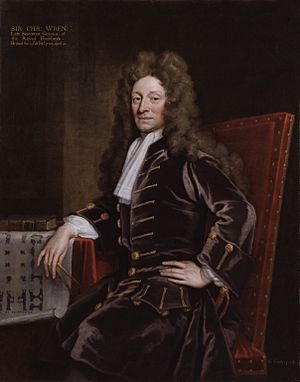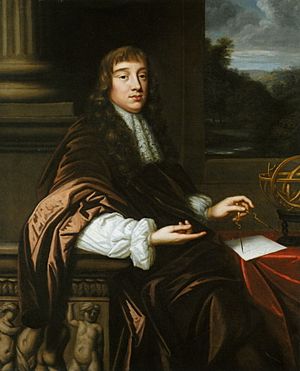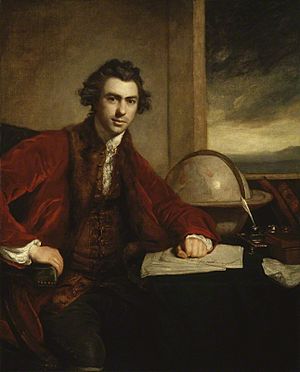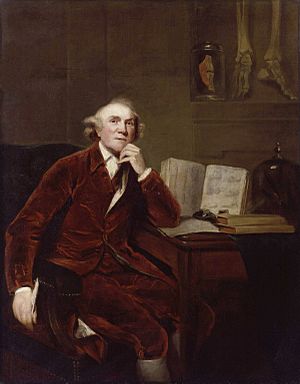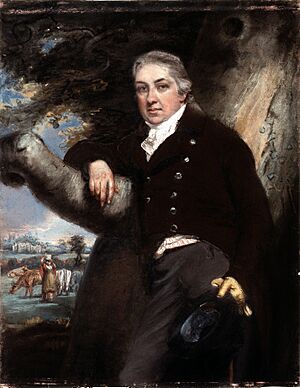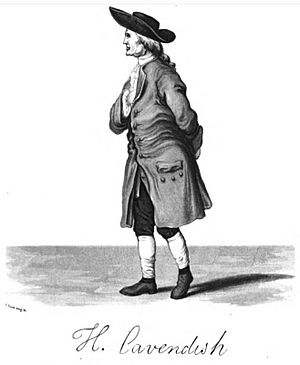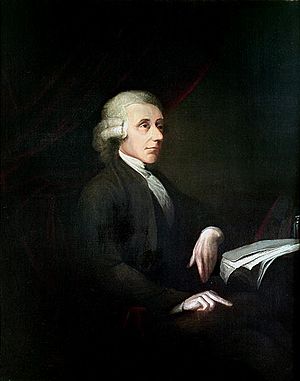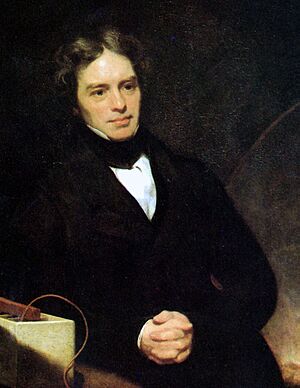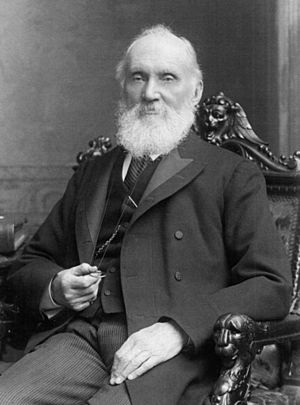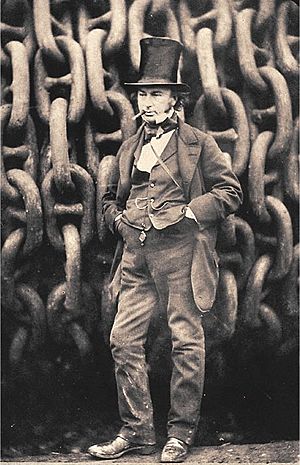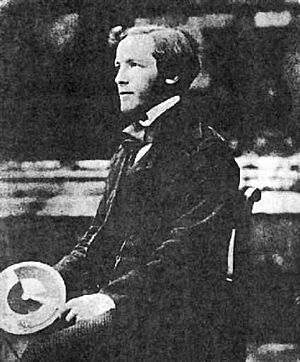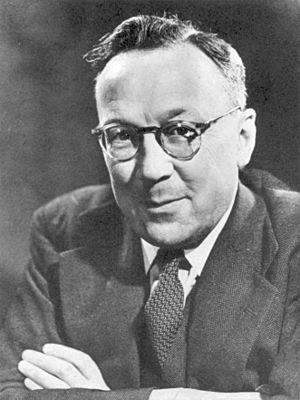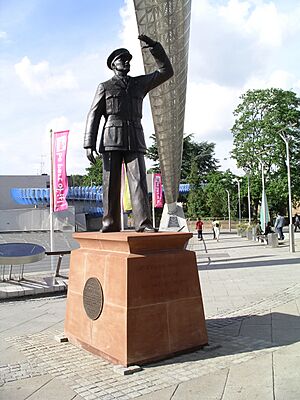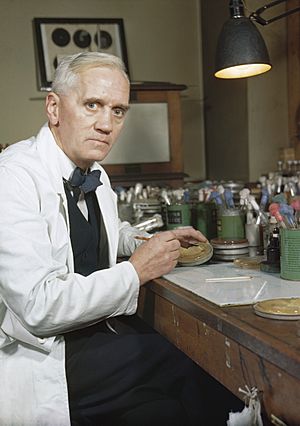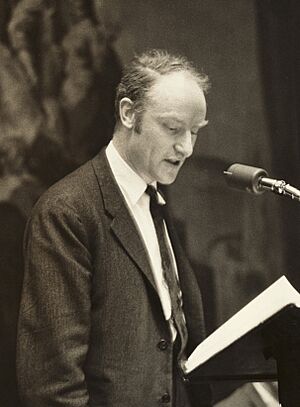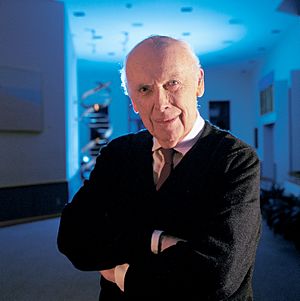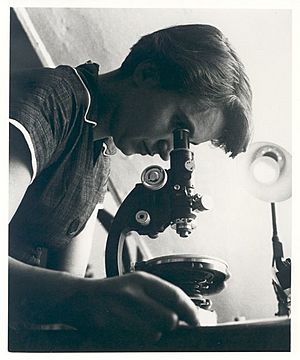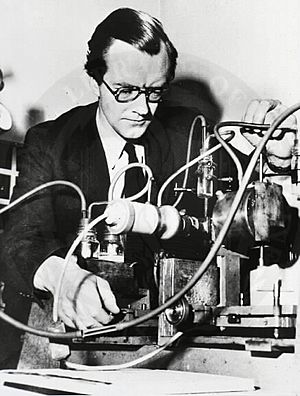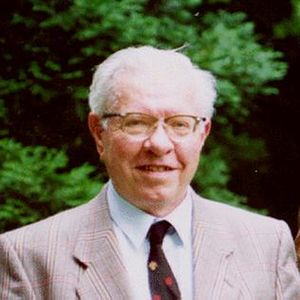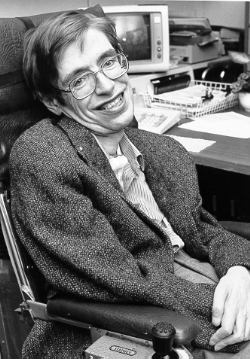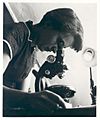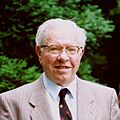Genius of Britain facts for kids
Quick facts for kids Genius of Britain |
|
|---|---|
| Genre | Documentary |
| Directed by | Tim Usborne |
| Composer(s) | Dru Masters |
| Country of origin | United Kingdom |
| Original language(s) | English |
| No. of series | 1 |
| No. of episodes | 5 |
| Production | |
| Running time | 50 minutes |
| Production company(s) | IWC Media Ltd. |
| Release | |
| Original network | Channel 4 |
| Original release | 30 May – 3 June 2010 |
Genius of Britain: The Scientists Who Changed the World is an exciting five-part TV show from 2010. It features famous British scientists who tell the stories of other amazing British scientists and inventors. The series explores how these brilliant minds shaped our world with their discoveries.
Contents
- Meet the Brilliant Presenters
- Amazing Discoveries: A Journey Through Science
- Episode 1: The First Five Discoveries
- Episode 2: A Roomful of Brilliant Minds
- Episode 3: The Lights Come On
- Episode 4: Out of the Darkness
- Episode 5: Asking Big Questions
- Francis Crick: Unlocking the DNA Code
- James D. Watson: The DNA Structure
- Rosalind Franklin: X-ray Vision for DNA
- Maurice Wilkins: DNA's X-ray Pioneer
- Fred Hoyle: Stars and the Universe
- Stephen Hawking: Black Holes and Cosmology
- W. D. Hamilton: The Genetics of Altruism
- Carbon Nanotubes: Tiny Wonders of the Future
- Images for kids
Meet the Brilliant Presenters
This documentary is presented by some of Britain's top scientific minds. They guide you through the incredible history of discovery.
Main Host
- Stephen Hawking – A world-famous theoretical physicist and cosmologist. He studies the universe and how it works.
Segment Presenters
- Jim Al-Khalili – A theoretical physicist who explores the mysteries of the universe.
- David Attenborough – A beloved broadcaster and naturalist. He is famous for his nature documentaries.
- Richard Dawkins – An evolutionary biologist who studies how living things change over time.
- James Dyson – A famous industrial designer and inventor, known for his vacuum cleaners.
- Olivia Judson – An evolutionary biologist who studies how life evolves.
- Paul Nurse – A geneticist who studies genes and heredity.
- Kathy Sykes – A physicist who studies matter and energy.
- Robert Winston – A medical doctor and scientist who works in fertility.
Amazing Discoveries: A Journey Through Science
This section explores the incredible scientists featured in each episode of Genius of Britain.
Episode 1: The First Five Discoveries
This episode looks at five early British scientific heroes who laid the groundwork for modern science.
Christopher Wren: Master Builder and Thinker
Sir Christopher Wren was an English thinker, anatomist (someone who studies the body), and astronomer (someone who studies stars). He was also a pioneering architect, famous for designing St. Paul's Cathedral. As the first president of the Royal Society, he pushed for practical experiments.
Robert Hooke: The Curious Observer
Robert Hooke was an English thinker, instrument maker, and astronomer. He was also a pioneering microbiologist. He was the experiment curator for the Royal Society. He was the first to draw insects as seen through a microscope.
Robert Boyle: The Father of Modern Chemistry
Robert Boyle was an Anglo-Irish thinker and pioneering chemist. With help from Robert Hooke, he created the air pump. This helped him discover how air works and why it's important for life. He showed his findings to the Royal Society.
Isaac Newton: Laws of Motion and Gravity
Sir Isaac Newton was an English thinker, mathematician, astronomer, and alchemist. His work on optics (light), gravity, and laws of motion changed science forever. He was knighted and became president of the Royal Society.
Edmond Halley: Mapping the Stars
Edmond Halley was an English thinker, astronomer, and mathematician. He mapped the stars in the southern hemisphere. This led to his role at the Royal Society and becoming the second Astronomer Royal.
Episode 2: A Roomful of Brilliant Minds
This episode highlights more amazing scientists from a later period, whose work sparked big changes.
Joseph Banks: Explorer of Nature
Sir Joseph Banks was a British naturalist and botanist. He collected many exotic plants and animals while sailing with James Cook. He later became a long-serving director of Kew Gardens and president of the Royal Society.
James Watt: Powering the Industrial Revolution
James Watt was a Scottish inventor and mechanical engineer. He improved the Watt steam engine, which was a huge step forward. His work helped kickstart the Industrial Revolution in Britain and around the world.
John Hunter: Modernizing Surgery
John Hunter was a Scottish surgeon and anatomist. He collected many specimens, now at the Hunterian Museum and Art Gallery. He made detailed maps of the human body and how its parts work. His work transformed surgery from old practices into a scientific field.
Edward Jenner: The First Vaccine
Edward Jenner was an English physician and pioneering immunologist. He was trained by John Hunter. He performed a groundbreaking experiment by using cowpox to protect against smallpox. This led to the world's first vaccine.
Henry Cavendish: Discovering Hydrogen
Henry Cavendish was a British thinker and chemist. He discovered and studied hydrogen, which he called 'inflammable air'. This discovery paved the way for hydrogen balloons. Working with Joseph Priestley, he also found out what water is made of.
Joseph Priestley: The Air We Breathe
Joseph Priestley was an English thinker, theologian, and chemist. He studied the properties of air. He invented soda water and famously discovered oxygen. He also worked with Henry Cavendish to find out what water is made of.
Episode 3: The Lights Come On
This episode explores the scientists who brought light and understanding to the world through electricity and new theories.
Michael Faraday: Electricity and Magnetism
Michael Faraday was a British scientist who made huge contributions to the study of electromagnetism and electrochemistry. He discovered the basic ideas behind electromagnetic induction, diamagnetism, and electrolysis.
Alfred Russel Wallace: Evolution by Natural Selection
Alfred Russel Wallace was a British naturalist, explorer, and biologist. He is best known for coming up with the idea of evolution through natural selection on his own. His paper on this topic was published alongside some of Charles Darwin's writings in 1858.
William Thomson (Lord Kelvin): Laws of Energy
William Thomson, also known as Lord Kelvin, was a British mathematical physicist and engineer. He did important work on electricity and created the first and second laws of thermodynamics. He helped bring together the field of physics into its modern form.
Isambard Kingdom Brunel: Engineering Marvels
Isambard Kingdom Brunel was a British mechanical and civil engineer. He designed the Great Western Railway, the Clifton Suspension Bridge, and the famous ship SS Great Britain. He also created many other important ships, tunnels, and bridges. He completely changed public transport and modern engineering.
James Clerk Maxwell: Unifying Light and Electricity
James Clerk Maxwell was a British mathematical physicist. He created the classic theory of electromagnetic radiation. For the first time, he showed that electricity, magnetism, and light were all parts of the same phenomenon.
Episode 4: Out of the Darkness
This episode focuses on scientists whose inventions and discoveries helped us see and understand the world in new ways, especially during challenging times.
Robert Watson-Watt: The Invention of Radar
Robert Watson-Watt was a British pioneer of radar technology. He showed the first practical radio system for finding aircraft. He successfully bounced a radio wave off a Handley Page Heyford aircraft, proving radar could work.
Alan Turing: The Father of Modern Computing
Alan Turing was a British computer scientist, mathematician, and codebreaker. He created the idea of the Turing machine, which is a model for a general purpose computer. His work was crucial during World War II for breaking codes.
Frank Whittle: Inventing the Jet Engine
Sir Frank Whittle was a British Royal Air Force (RAF) engineer. He is credited with inventing the turbojet engine all by himself. Whittle's jet engines were developed years before those of Germany's Hans von Ohain.
Alexander Fleming: The Discovery of Penicillin
Sir Alexander Fleming was a British biologist and pharmacologist. He discovered the world's first antibiotic substance, penicillin. He found it from the mould Penicillium notatum. For this life-saving discovery, he won the Nobel Prize in Physiology or Medicine.
Paul Dirac: Quantum Mechanics Pioneer
Paul Dirac was a British theoretical physicist. He made huge contributions to the early development of quantum mechanics and quantum electrodynamics. He created the Dirac equation, which describes how tiny particles called fermions behave. He also predicted the existence of antimatter.
Episode 5: Asking Big Questions
This final episode explores scientists who asked the biggest questions about life, the universe, and everything.
Francis Crick: Unlocking the DNA Code
Francis Crick was a British molecular biologist and biophysicist. He is most famous for helping to discover the structure of the DNA molecule in 1953 with James Watson. He shared the 1962 Nobel Prize in Physiology or Medicine with Watson and Maurice Wilkins.
James D. Watson: The DNA Structure
James D. Watson is an American molecular biologist and geneticist. He is best known as one of the co-discoverers of the structure of DNA in 1953. He worked with Francis Crick and Rosalind Franklin.
Rosalind Franklin: X-ray Vision for DNA
Rosalind Franklin was a British chemist and X-ray crystallographer. She made important contributions to understanding the molecular structures of DNA, RNA, viruses, coal, and graphite. Her X-ray images were crucial for discovering the DNA structure.
Maurice Wilkins: DNA's X-ray Pioneer
Maurice Wilkins was a New Zealand-born British physicist and molecular biologist. He is known for his work at King's College London on the structure of DNA. He shared the Nobel Prize in Physiology or Medicine with Crick and Watson.
Fred Hoyle: Stars and the Universe
Sir Fred Hoyle was a British astronomer. He is known for his theory of stellar nucleosynthesis, which explains how elements are made in stars. He also famously coined the term "Big Bang" on BBC radio, even though he disagreed with the theory.
Stephen Hawking: Black Holes and Cosmology
Stephen Hawking was a British theoretical physicist and cosmologist. His scientific work includes the Penrose–Hawking singularity theorems. He also predicted that black holes emit radiation. He worked on a theory that combines general relativity and quantum mechanics.
W. D. Hamilton: The Genetics of Altruism
Bill Hamilton was a British evolutionary biologist. His work explained the genetic reasons for altruism (when animals help others at their own cost). This insight was a key part of developing a gene-centric view of evolution.
Carbon Nanotubes: Tiny Wonders of the Future
Carbon Nanotubes are tiny, cylindrical carbon molecules. They are very useful for nanotechnology, electronics, optics, and other areas of materials science. They are incredibly strong and could even be used for things like a space elevator.
Images for kids


